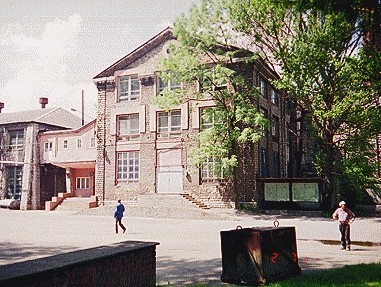The cache is located in the workshop area of the former Noblessner shipyard, in front of the former power plant building. The power plant building was built between 1914 and 1915 as part of the Noblessner submarine plant. The building was designed by architect V. Sakharov. In 1917, the factory was evacuated, and the building was leased to port factories. It was partly used as a canteen during the Soviet era. Today, the building is a renovated office building.
Noblessner's history began in 1912, when two St. Petersburg businessmen, Emanuel Nobel (Alfred Nobel's nephew) and Arthur Lessner, built the most important submarine factory in Tsarist Russia at the time. The factory was named Noblessner by the names of two men.
Between 1914 and 1917, nine Bars submarines were built at Noblessner Shipyard for the Baltic Fleet and three for the Pacific Fleet. At the neighboring Volta plant, all electrical equipment was manufactured for the submarines under construction.
In 1916, the factory received another order to build 20 large ocean submarines, but due to the October Revolution of 1917, they were not built. Due to the lack of orders, the factory was declared bankrupt in 1925, and the buildings were divided between several companies, which, among other things, built smaller ships here. At the beginning of the Soviet occupation, fragmented companies were reunited. In the years 1944–1951, the factory was called Tallinna Meretehas, and mine trawlers of the Baltic fleet were repaired here. In the following decades, Meretehas operated under the name of Shipyard No. 7 and 7, building bases for the Soviet Navy and repairing whaling vessels and trawlers.
After the restoration of Estonian independence in 1991, the factory was renamed Tallinna Meretehas. The patrol ship Pikker was built here for the Estonian Border Guard Board and the submarine Lembit was also repaired before it was handed over to the Estonian Maritime Museum.
Since the bankruptcy of Tallinna Meretehase in 2001, the factory has belonged to the BLRT Group, which, in cooperation with partners, is developing the Noblessner port city and residential quarter.

Aare paikneb endise Noblessneri laevatehase tsehhide piirkonnas, endise elektrijaama hoone ees. Elektrijaama hoone on ehitatud aastatel 1914-1915 Noblessneri allveelaevade tehase osana. Hoone on projekteerinud arhitekt V. Saharov. 1917. aastal tehas evakueeriti, hoone renditi sadamatehastele. Nõukogude ajal osaliselt oli kasutusel sööklana. Tänaseks päevaks on hoone renoveeritud büroohooneks.
Noblessneri ajalugu algas 1912. aastal, mil kaks Peterburi ärimeest – Emanuel Nobel (Alfred Nobeli vennapoeg) ja Arthur Lessner – rajasid siia toonase Tsaari-Venemaa tähtsaima allveelaevade tehase. Kahe mehe perekonnanimedest saigi tehas nime Noblessner.
Aastatel 1914–1917 ehitati Noblessneri Laevatehases üheksa Bars-tüüpi allveelaeva Läänemere laevastiku jaoks ja kolm Vaikse ookeani laevastiku jaoks. Naabruses asunud Volta tehases valmistati ehitatavatele allveelaevadele kogu elektriseadmestik.
1916. aastal sai tehas veel tellimuse 20 suure ookeaniallveelaeva ehitamiseks, kuid 1917. aasta oktoobrirevolutsiooni tõttu jäidki need ehitamata. Tellimuste vähesuse tõttu kuulutati 1925. aastal välja tehase pankrot ning hooned jagati mitme ettevõtte vahel, kes muuhulgas ehitasid siin väiksemaid laevu. Nõukogude okupatsiooni algul liideti killustunud ettevõtted taas üheks. Aastatel 1944–1951 kandis tehas nime Tallinna Meretehas ning siin remonditi Balti laevastiku miinitraalereid. Järgmistel kümnenditel tegutses käitis Meretehas nr 7 ja 7. laevaehitustehase nime all, ehitades aluseid Nõukogude mereväele ning remontides vaalapüügilaevu ja kalatraalereid.
Pärast Eesti iseseisvuse taastamist 1991. aastal sai tehase nimeks Tallinna Meretehas. Siin ehitati Eesti Piirivalveametile patrull-laev Pikker ja remonditi ka allveelaeva Lembit enne selle üleandmist Eesti Meremuuseumile.
Alates Tallinna Meretehase pankrotist 2001. aastal kuulub tehas BLRT Grupile, kes koostöös partneritega arendab Noblessneri sadamalinnakut ja elamukvartalit.